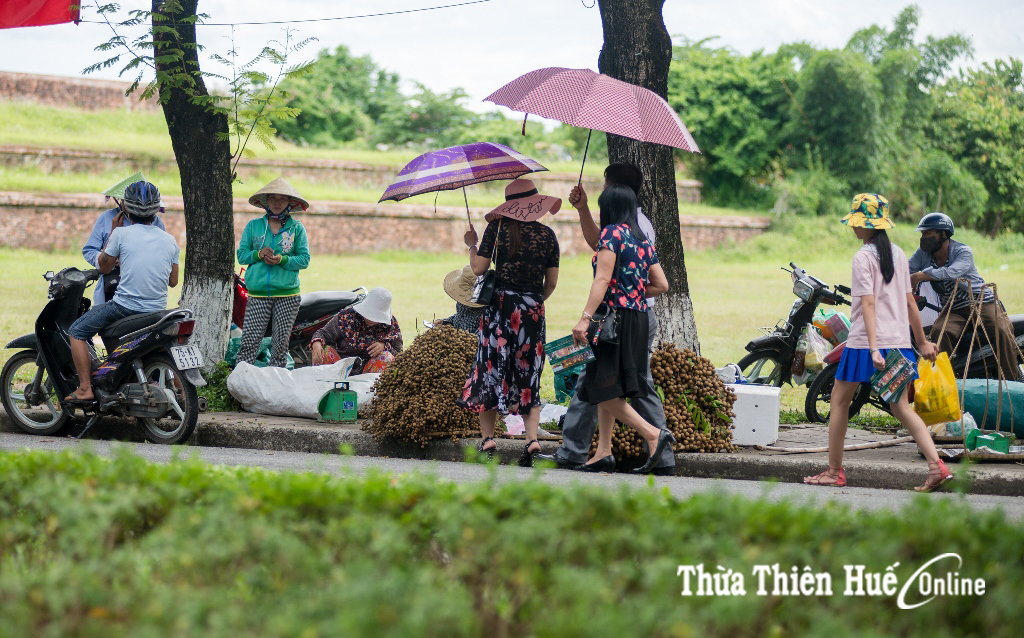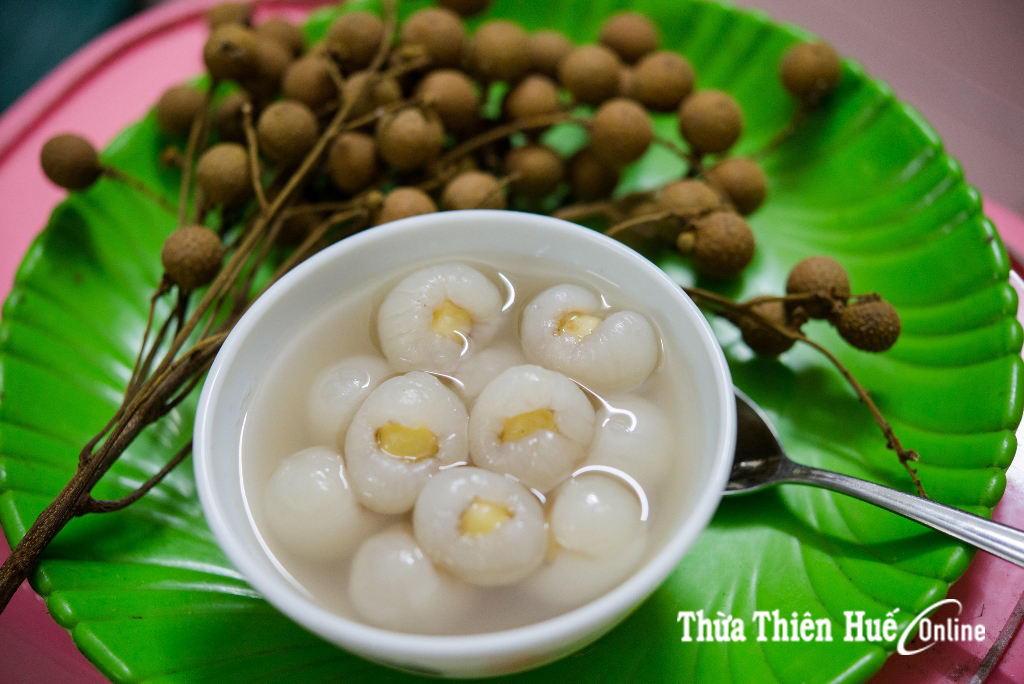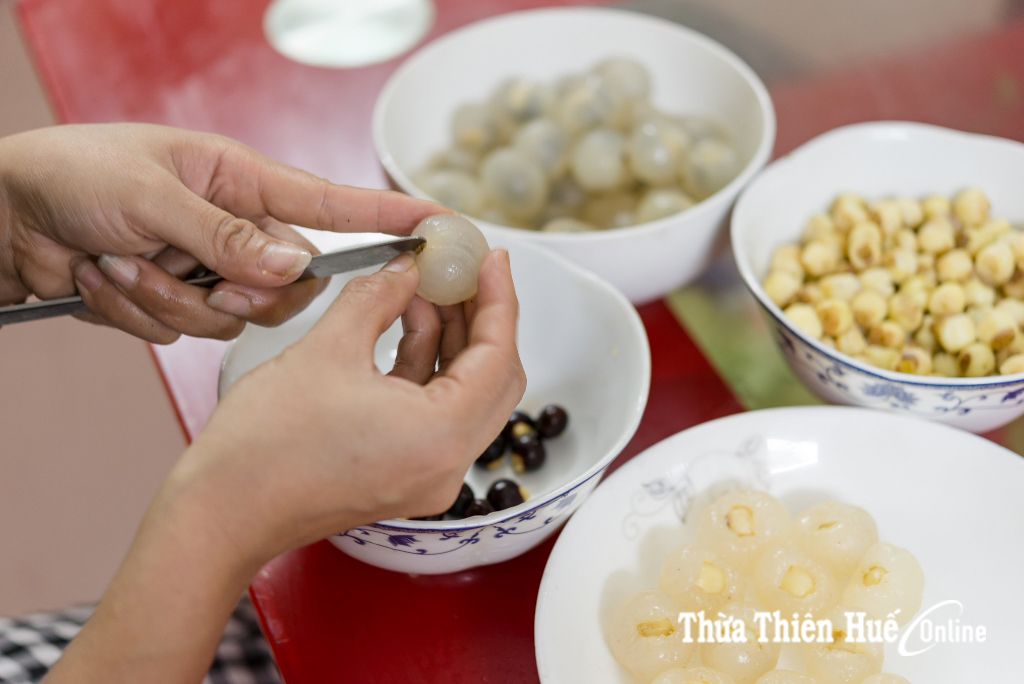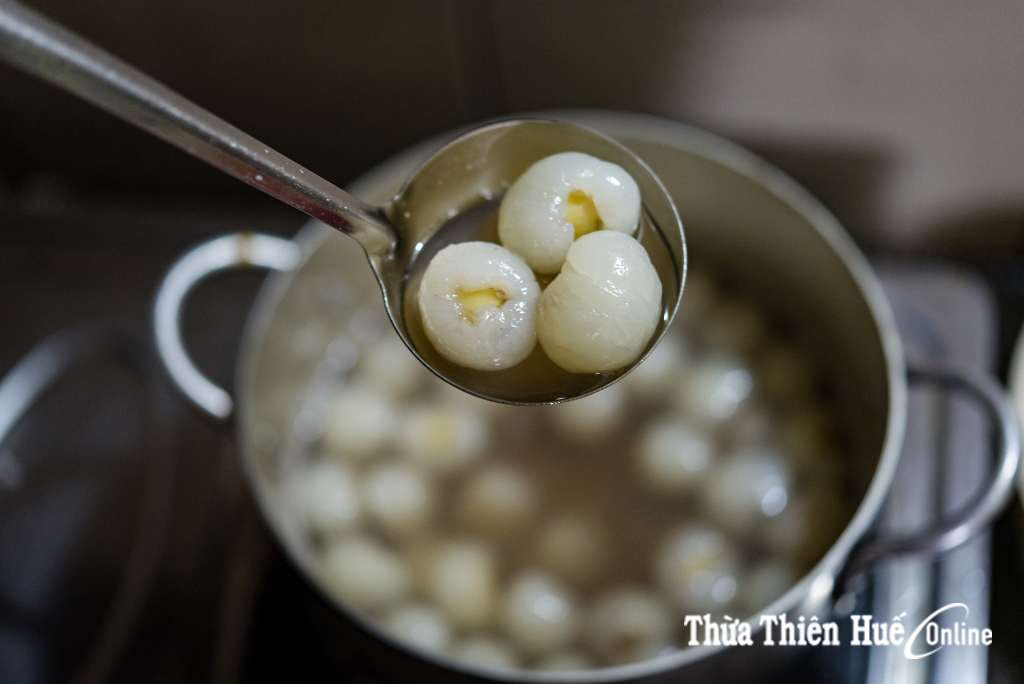The pulps are very translucent, gently sweet and slightly fragrant
When the spring drizzle appears, longan flowers start to bloom. Not pervading like the scents of Areca spadices or grapefruit blossoms, the tiny, milk white longan flowers which bunch into clusters slightly pervade and attract the studious bees. The perfume of longan flowers pervades the ancient capital, the corner of a certain old temple, or the familiar streets which solicit people’s footsteps.
.jpg)
The perfume of longan flowers pervades the air
In July days, when coming to visit Hue, you will be interested in bumping into the images of the roadside with rows of longan trees full of fruits, or halt at the fresh longan loads on the streets in the Citadel’s inlying area or in the markets. Many people have compared these hawkers to the messengers who bring the nested longans – the ancient capital’s speciality to the table companions.
Coming to garden houses in Phu Mong (Kim Long Ward) or those in Thuy Bieu, Huong Long, etc., (Hue city) and then, walking along Dong Ba market, Quang Duc Gate, Thuong Tu Gate, etc., you can see lots of ancient longan trees luxuriant with longans which are staying out in the sun or carefully nested in the sedge bags, spathes, etc.
.jpg)
In a small corner of Dong Ba market, Mrs. Nguyen Thu Huong (65 years old) is considered as one of the sellers who have the longest senioirity with 30 years selling Hue longans. “Hue nested longans are very delicious. Its pulps are thick and sweeter than the longans growing in the South, Thailand or Hung Yen, etc. If I want to buy the original Hue nested longans, I have to order from the owners of longan gardens in Kim Long, Thuy Bieu since the longan flowers bloom”, Mrs. Huong started the conversation about Hue longans with a guest from other province.
With an instinct of a well-experienced fruit seller, Mrs. Huong quicky showed the buyers many ways to recognize Hue nested longans and those of other places. According to Mrs. Huong, it is not difficult to recognize Hue longans because the longans are round and not too big, the longans’ skins are thick, tough and bumpy with green nerves. When eating, Hue longans taste fresh and gently sweet because the color of the longan pulps are very translucent, and less watery than Thai longans. “It is not enough to identify by eyes. You have to try one to two fruits to know whether it is Hue nested longan or not”, the longan sellers whom I have met briefly summarized about Hue longans like that.

Hue nested longans are sold on many streets, especially in the Citadel’s inlying area
Sitting at the end of Dinh Tien Hoàng Street, the longan stall of Mrs. Le Thi Xuan (52 years old, Thuan Loc Ward) has attracted many customers. Mrs. Xuan said that she sold about 70 to 100kg nested longan each day and got profit of over 200 thousands VND. With the unnested longans whose fruits are smaller, she sold about 30 thousand VND per kilogram, and the bigger ones were sold with the price of about 55 to 60 thousand VND per kilogram. “Nowadays, the customers are more professional in choosing longans so they can identify the good ones immediately after peeling the longans’skins”, Mrs. Xuan shared.
.jpg)
Hue nested longans with various sizes are available for sale on the roads
High-priced nested nested longans
Hue nested longans will be bigger and more delicious when it is nested in cages. In recent years, the farmers have not nested the longans quite often because of the great expense. (10 thousand VND per cage while the selling price is about 40 to 60 thousand VND per kilogram, depending on each kind of longans).
“In the past, the work of nesting the longans was very popular when many Hue longan trees were planted. Those who did the work of nesting longans were welcomed solicitingly by the garden owners and usually paid handsomely. However, the job of nesting longan has been fallen into oblivion because Hue nested longans become absent day by day,” a person working this business shared.

It is very strenuous to nest and harvest the longans
According to the guide of the people in this trade, I met Mr. Vo Van Hieu (70 years old), who is considered the oldest person still doing the job of nesting longans. Thanks to the 30 year seniority working in this trade, he knows longans like himself. At the result, the garden owners often let him choose which longan trees should be nested and which ones should be harvested early. Hence, he is always busy working with auxiliary devices which support his climb such as the 12 to 14-meter-tall ladder, ropes, sedge cushions, etc., these are the indispensable items of the people specializing in nesting longans.
After many years identifying himself with this trade, no matter how up and down it is, he is always proud of this trade because it helps him to earn money for his family. Furthermore, it also contributes to bringing a kind of fruits to Hue people away from home and helps them recall the memories about their hometown.
The sweet soup with Hue flavor
The season of Hue nested longans coincides with the lotus season. Through the skillful hands of Hue women, they can process the lotus seeds and longans sweet soup which is delicious, fresh and suitable to enjoy in summer days. To cook this soup, the lotus seeds have to be steamed. The big, watery longans have to be pitted to cover the well-cooked lotus seeds. All of them are cooked in rock sugar juice to create the Hue food which is both simple and luxurious because Hue women made it with all their hearts.

The lotus seeds covered by pitted longans cooked with rock candy juice to make a special sweet soup

Being scrupulous in pitting the longans

The gently sweet and delicious lotus seed nested in pitted longans sweet soup
By Đ. Duc - D. Tuyên - L.Khoa - L.Tue - Ng. Quan
